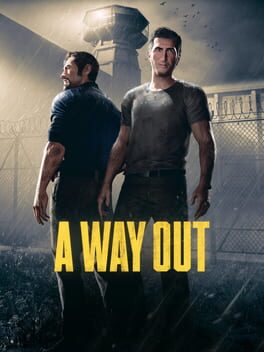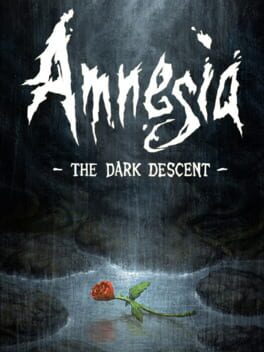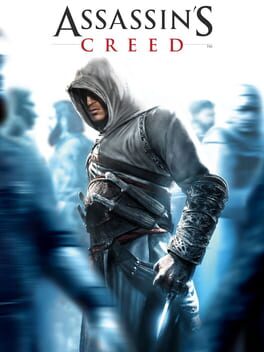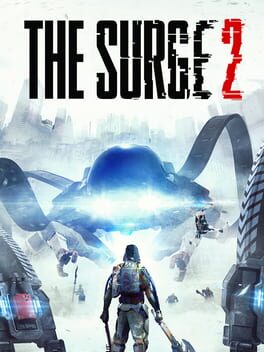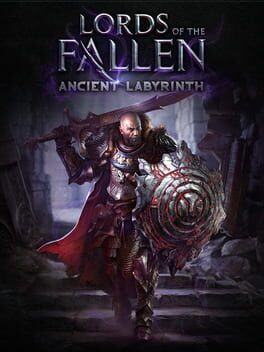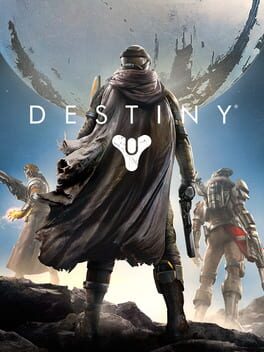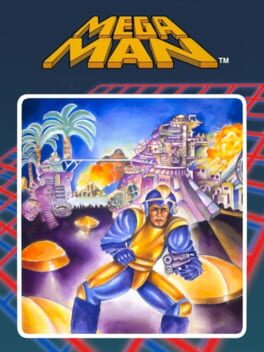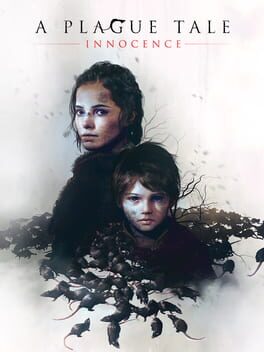squid0812
BACKER
2018
A difficult game to critique, for two reasons. Firstly, so much of its appeal is due to its reliance on couch co-op (this is playable as online co-op but it seems to me like that would eliminate a lot of the fun). Secondly, I have no clue if the people who made this game were in on the joke - this is low-key one of the funniest games I’ve ever played, but the humor seems to be at least partly unintentional.
The story here is a pile of cliches derived from American crime movies of the past fifty years. Again, I’m not sure if the developers wanted us to take this plot seriously, but my wife and I were laughing constantly at how the game continuously churns out bad, weirdly off-kilter imitations of scenes that you’ve seen in a hundred different movies - and all with a straight face. A large part of the goofiness is derived from the voice acting, which ranges from eerily emotionless (Vincent) to sounding like an alien in disguise visiting Earth for the first time (Leo). So many of the line readings here sound strangely divorced from their context. In a way, it helps - every time we got bored with the story, one of the characters would say something ridiculous and get us laughing again. But, again, expecting much beyond a few so-bad-it’s-good chuckles from the story is a fool’s errand.
Gameplay-wise, the co-op elements are occasionally intriguing - there are a few sequences, like the jailbreak, that force the players to work together in an interesting way. As the game goes on, the gameplay gets a lot less engaging, though. There are a few sequences in which the players are let loose to explore individually - but this is not an really an exploration-based game, so I typically found myself bored stiff during these parts. There a few shooter sequences as well, and these also felt pretty perfunctory to me. It felt like they had a solid concept for some engaging gameplay, but they didn’t iterate enough on it to justify a 5-6 hour game.
With all that being said, I won’t deny that I had a good time with my wife while playing this - the game works as a vehicle for social interaction. But looking at it as a game rather than as a chance to goof around with family or friends leaves it wanting.
The story here is a pile of cliches derived from American crime movies of the past fifty years. Again, I’m not sure if the developers wanted us to take this plot seriously, but my wife and I were laughing constantly at how the game continuously churns out bad, weirdly off-kilter imitations of scenes that you’ve seen in a hundred different movies - and all with a straight face. A large part of the goofiness is derived from the voice acting, which ranges from eerily emotionless (Vincent) to sounding like an alien in disguise visiting Earth for the first time (Leo). So many of the line readings here sound strangely divorced from their context. In a way, it helps - every time we got bored with the story, one of the characters would say something ridiculous and get us laughing again. But, again, expecting much beyond a few so-bad-it’s-good chuckles from the story is a fool’s errand.
Gameplay-wise, the co-op elements are occasionally intriguing - there are a few sequences, like the jailbreak, that force the players to work together in an interesting way. As the game goes on, the gameplay gets a lot less engaging, though. There are a few sequences in which the players are let loose to explore individually - but this is not an really an exploration-based game, so I typically found myself bored stiff during these parts. There a few shooter sequences as well, and these also felt pretty perfunctory to me. It felt like they had a solid concept for some engaging gameplay, but they didn’t iterate enough on it to justify a 5-6 hour game.
With all that being said, I won’t deny that I had a good time with my wife while playing this - the game works as a vehicle for social interaction. But looking at it as a game rather than as a chance to goof around with family or friends leaves it wanting.
A lovely and touching story that reminded me of something out of a Wes Anderson movie is the main draw here, and that was enough to mostly silence my qualms about the dearth of actual gameplay mechanics. This goes even further down the ‘walking sim’ lineage than something like Gone Home. Although it initially seems like exploration will be an element of the play, this is actually more or less completely linear, and you would have to intentionally go out of your way to miss any content. Exploring off the rails that the game wants you to follow is pointless - there are no safes to unlock or puzzles to solve like you find in other games of this ilk. Occasionally, the game will even seal off parts of the house you’ve already explored to keep the player on the path. I was left missing some sort of gameplay mechanic to keep the actual process of walking around the property engaging.
Thankfully, the house is an excellent set piece, full of odd details and bizarre architectural improvisations that are always a joy to look at. And the mini-games that form the largest chunk of the play are sometimes wildly creative. The initial sequence involving a hungry adolescent and a late scene involving a depressed cannery worker are particular standouts. While never exactly ‘fun’, many of these short and simple scenarios do a sterling job of making these characters feel real and fleshed out. Consequently, every time one of these short stories ends and you are transported back to the house in present day, the environmental details are re-contextualized and enhanced in a way that is really satisfying. Not all of the stories are quite so compelling - a few of them are rather half-assed - but by and large they contribute to an affecting and melancholy portrait of this strange and precocious family.
This could’ve stood to add more mechanical elements to make it more of a game, but the story is absolutely a treat that makes this worth experiencing.
Thankfully, the house is an excellent set piece, full of odd details and bizarre architectural improvisations that are always a joy to look at. And the mini-games that form the largest chunk of the play are sometimes wildly creative. The initial sequence involving a hungry adolescent and a late scene involving a depressed cannery worker are particular standouts. While never exactly ‘fun’, many of these short and simple scenarios do a sterling job of making these characters feel real and fleshed out. Consequently, every time one of these short stories ends and you are transported back to the house in present day, the environmental details are re-contextualized and enhanced in a way that is really satisfying. Not all of the stories are quite so compelling - a few of them are rather half-assed - but by and large they contribute to an affecting and melancholy portrait of this strange and precocious family.
This could’ve stood to add more mechanical elements to make it more of a game, but the story is absolutely a treat that makes this worth experiencing.
A pretty dull DLC in an otherwise enjoyable game. The interesting premise is mostly wasted - as in Inquisition’s Trespasser DLC, your player character finds himself unneeded and adrift in the time following the main campaign. In this case, the ultimate goal is finding Morrigan, your sorceress companion with an agenda from the main game.
Virtually everything about this feels mailed in from a gameplay standpoint - the companions are only barely sketched, the combat encounters are mostly mobs requiring little strategy, and almost all of the environments are lazily reused. Strangely, this is arguably the most significant piece of Dragon Age DLC from a lore standpoint, as it greatly expands upon the story of the eluvians, which plays a huge role in later games. The final encounter with Morrigan is tantalizing, but the gameplay leading up to it is so limp that it hardly feels worth it.
Virtually everything about this feels mailed in from a gameplay standpoint - the companions are only barely sketched, the combat encounters are mostly mobs requiring little strategy, and almost all of the environments are lazily reused. Strangely, this is arguably the most significant piece of Dragon Age DLC from a lore standpoint, as it greatly expands upon the story of the eluvians, which plays a huge role in later games. The final encounter with Morrigan is tantalizing, but the gameplay leading up to it is so limp that it hardly feels worth it.
Of the three DLCs for Dark Souls II, this is probably the worst in terms of level and encounter design. That being said, the level design is still miles ahead of the base game, and despite their obnoxious configurations, most of the new enemies are fun to fight one-on-one (I especially enjoyed the giant guys who have lava pouring out of their shoulders to punish circle strafing). Most significantly, two of three new bosses here are among the the best in the series. Sir Alonne is a tense and challenging honor duel who somehow makes his deplorable boss run completely worth it. And the Fume Knight is another superb one-on-one fight with a clever mechanic tied into level exploration. These two bosses alone make the expansion worth your time (the third boss is a lazy reskin of the Smelter Demon tucked away at the end of one of the ridiculously hostile challenge areas that were apparently obligatory in all of the DSII DLCS). Add on some level exploration that is very good (even if it’s not quite as strong as Shulva or Frozen Eleum Loyce) and you have a quality expansion that anyone who picks up Dark Souls II should definitely play.
This review contains spoilers
Due largely to a brilliant combination of extremely creepy sound design and expertly deployed interface manipulation, this is one of the scarier games I’ve played. The slow burn of the early game works on me in a big bad way. The standard haunted house staples (creaking floorboards, distant screams, etc.) work unusually well with the impressive sense of restraint this game has (almost all of the scares rely on brief and opaque glimpses of disturbing things rather than your typical jump scares). This game is stunningly successful at creating the illusion that you are being pursued, even though it’s actually pretty rare that you are in mortal danger.
I was still engaged by the monsters in the second half of the game, but the sense of dread wasn’t quite as potent as I started to see the seams of how the monster encounters worked. Avoiding monsters mostly consists of hiding (spots are plentiful) until the monsters despawn, after which you are basically safe until you hear the next telltale groan. When the monsters first started showing up, hearing the approaching groaning was terrifying, but I became more inured to it as these very similar encounters continued to occur (I wish they had been a bit more creative with deploying the monsters as the game proceeds. There are one or two points where the presence of a monster is fixed and they will never despawn, so you have to figure out a way around them - these were great and tense and I wish the game had more of this). Thankfully, the second half of the game successfully deploys a different kind of horror - namely, the fear of being completely exposed to the whims of a powerful, uncaring force. There are some truly terrifying sequences in which the player discovers evocatively creepy torture devices, and further exploration provides equally unsettling descriptions of their use. As body horror, it’s deeply effective (if perhaps a bit much for the squeamish).
The majority of the playtime here is spent figuring out physics-based puzzles and collecting items in order to proceed. 90% of the puzzles worked fine for me - a few even made me feel clever, which is always a great feeling. The 10% that didn’t work, though, were illogical and annoying (giving away as little as possible, a puzzle involving pipes in the control room and the location of a hatch needed to fix some levers in the nave had me slamming my head against the wall).
As for the story, my feelings on it were similar to how I felt about the gameplay - it starts off very strong, with a solid pitch (the PC intentionally gave himself amnesia - figure out why) and an alluring sense of mystery. The writing and voice acting in the flashbacks and diaries which comprise the game’s storytelling are actually quite competent, especially considering the fairly low budget nature of the game. As the game goes on and gets more gory, the PC learns some less than savory things about himself that tread into some fairly standard yet well-executed ‘there’s darkness within all of us’ tropes. Unfortunately, the ending fell a bit flat for me - it feels a bit goofy rather than scary, and the abrupt and unceremonial (ha) shift to the credits made me feeling like the game was missing an ending cutscene of some kind.
On the whole, an important game that does a spot-on job of using creepy atmosphere to create a sense of pervading dread. Absolutely a must-play for those who love survival horror.
Edit 4/30 - Playing A Machine for Pigs has actually made me like the game more in retrospect - I definitely underrated how rich of a mechanical experience it is, beyond merely being an effective narrative.
I was still engaged by the monsters in the second half of the game, but the sense of dread wasn’t quite as potent as I started to see the seams of how the monster encounters worked. Avoiding monsters mostly consists of hiding (spots are plentiful) until the monsters despawn, after which you are basically safe until you hear the next telltale groan. When the monsters first started showing up, hearing the approaching groaning was terrifying, but I became more inured to it as these very similar encounters continued to occur (I wish they had been a bit more creative with deploying the monsters as the game proceeds. There are one or two points where the presence of a monster is fixed and they will never despawn, so you have to figure out a way around them - these were great and tense and I wish the game had more of this). Thankfully, the second half of the game successfully deploys a different kind of horror - namely, the fear of being completely exposed to the whims of a powerful, uncaring force. There are some truly terrifying sequences in which the player discovers evocatively creepy torture devices, and further exploration provides equally unsettling descriptions of their use. As body horror, it’s deeply effective (if perhaps a bit much for the squeamish).
The majority of the playtime here is spent figuring out physics-based puzzles and collecting items in order to proceed. 90% of the puzzles worked fine for me - a few even made me feel clever, which is always a great feeling. The 10% that didn’t work, though, were illogical and annoying (giving away as little as possible, a puzzle involving pipes in the control room and the location of a hatch needed to fix some levers in the nave had me slamming my head against the wall).
As for the story, my feelings on it were similar to how I felt about the gameplay - it starts off very strong, with a solid pitch (the PC intentionally gave himself amnesia - figure out why) and an alluring sense of mystery. The writing and voice acting in the flashbacks and diaries which comprise the game’s storytelling are actually quite competent, especially considering the fairly low budget nature of the game. As the game goes on and gets more gory, the PC learns some less than savory things about himself that tread into some fairly standard yet well-executed ‘there’s darkness within all of us’ tropes. Unfortunately, the ending fell a bit flat for me - it feels a bit goofy rather than scary, and the abrupt and unceremonial (ha) shift to the credits made me feeling like the game was missing an ending cutscene of some kind.
On the whole, an important game that does a spot-on job of using creepy atmosphere to create a sense of pervading dread. Absolutely a must-play for those who love survival horror.
Edit 4/30 - Playing A Machine for Pigs has actually made me like the game more in retrospect - I definitely underrated how rich of a mechanical experience it is, beyond merely being an effective narrative.
2007
Frankly, this game is unplayable in 2021, and it really wasn’t much better in 2007. The game looks grayed out and drab in that peculiar way unique to games of the early PS3 / 360 era. Presumably aiming for a degree of historical realism, the game instead achieves the ignominious status of being utterly devoid of color and life. The aesthetic failures are pervasive - every character here (including Altair, our exceptionally whiny and petulant protagonist) is sketched in only the most cartoonish terms, and the attempts to recreate the ambience of the medieval Crusader states only results in three cities that feel and look more or less exactly the same. The story is generic and unsatisfying, ending as it does on a blatant sequel hook (there’s not nearly enough of the batshit craziness that helped distinguish the narrative of later games in the series).
All of these flaws would have been easier to swallow if the gameplay was enjoyable, but no luck: it’s dreadfully bland. The parkour is mildly amusing, but every other facet of the gameplay is a) boring as hell, b) constantly repeated, or c) both. In order to prepare for each assassination, the player is made to continually engage with the same three activities: pickpocketing, eavesdropping, and interrogation. None of these are particularly fun, and they are repeated ad nauseam with very little variation. The actual assassinations themselves are marred by a clunky stealth system (there were many times where I would get caught without having any idea of how or why). The swordplay is so bad I found myself wishing that getting caught would simply result in an instant death.
Mercifully, this is a lot shorter than most of the games in the series - but I’m still never getting those 11 hours back. Skip to the sequels!
All of these flaws would have been easier to swallow if the gameplay was enjoyable, but no luck: it’s dreadfully bland. The parkour is mildly amusing, but every other facet of the gameplay is a) boring as hell, b) constantly repeated, or c) both. In order to prepare for each assassination, the player is made to continually engage with the same three activities: pickpocketing, eavesdropping, and interrogation. None of these are particularly fun, and they are repeated ad nauseam with very little variation. The actual assassinations themselves are marred by a clunky stealth system (there were many times where I would get caught without having any idea of how or why). The swordplay is so bad I found myself wishing that getting caught would simply result in an instant death.
Mercifully, this is a lot shorter than most of the games in the series - but I’m still never getting those 11 hours back. Skip to the sequels!
2012
Neon, synths, and ultra-violence - that’s the game. And it works much better than it has any right to, largely due to an impressive commitment to capturing the essence (rather than the specific details) of a particular time and place (Miami, 1989), as well as frenetic and freewheeling gameplay that meshes beautifully with the synthwave soundtrack.
Take a look at a still photo of Hotline Miami gameplay, and it may strike one as crass, even amateurish. It’s only in the act of play that this aesthetic comes to life. The immensely satisfying gunplay, the way the doors spring open wildly as the player character bursts into a room, the way the screen subtly shifts and sways as you navigate the level - it’s details like these that make the play seem so ineffably rhythmic. The controls are bit odd and the difficulty will likely take some getting used to - but ultimately the gameplay here doesn’t really feel like anything else I’ve played. And that’s extremely valuable.
The story here is a surreal look at the PC’s psyche being slowly destroyed by the consequences of meaningless violence (one of the subtle and brilliant ways the game sells this is by abruptly cutting off the music and forcing you to walk back through the path of devastation you’ve wrought at end of each level). The story works best in the early and middle sections when everything is mysterious and suggestive. The final act is more or less a dud - the game is missing a genuine climax - but the flavor and atmosphere had me engaged till the very end.
Narrative misgivings aside, this is a unique game that shouldn’t be missed (assuming one isn’t queasy about violence).
Take a look at a still photo of Hotline Miami gameplay, and it may strike one as crass, even amateurish. It’s only in the act of play that this aesthetic comes to life. The immensely satisfying gunplay, the way the doors spring open wildly as the player character bursts into a room, the way the screen subtly shifts and sways as you navigate the level - it’s details like these that make the play seem so ineffably rhythmic. The controls are bit odd and the difficulty will likely take some getting used to - but ultimately the gameplay here doesn’t really feel like anything else I’ve played. And that’s extremely valuable.
The story here is a surreal look at the PC’s psyche being slowly destroyed by the consequences of meaningless violence (one of the subtle and brilliant ways the game sells this is by abruptly cutting off the music and forcing you to walk back through the path of devastation you’ve wrought at end of each level). The story works best in the early and middle sections when everything is mysterious and suggestive. The final act is more or less a dud - the game is missing a genuine climax - but the flavor and atmosphere had me engaged till the very end.
Narrative misgivings aside, this is a unique game that shouldn’t be missed (assuming one isn’t queasy about violence).
2019
A significant improvement on the first game. The devs at Deck13 seem to have finally learned their lesson about varying up their environments so the player doesn’t get bored or lost (the fatal flaw of both Lords of the Fallen and the first Surge). It’s not like the urban landscape is particularly riveting as a set piece, but at very least the environments are clearly delineated and differentiated from one another - I always had a good sense of where I was and where I needed to go next. Not exactly glowing praise, but it’s a step forward at least.
The mechanical changes from the original game also tend to be in this game’s favor. In the first game, it was easy to spam dismemberments and end up with a lot of unneeded vendor trash, but here slashing off limbs is tied to battery power, the same resource that you use to heal. So, the game creates an interesting choice - dismember the enemy for parts or hold on to the battery power for a potential future heal. Adding onto to the complexity of this system is the fact that you refill your battery power by attacking. This encourages aggression in a way that reminded me a little bit of Bloodborne’s rally system. Indeed, considering that this is also a much faster game than its predecessor, the shift from the stodginess of Dark Souls to the nimble ballet of Bloodborne is a rather apt analogy for the relationship between the original Surge and its sequel.
Except that Dark Souls and Bloodborne are packed to the gills with weird and evocative concepts and ineffable set pieces, while The Surge…well, it’s sci-fi gobbledygook in the worst way. Genuinely, I admire how the devs at Deck13 have clearly improved since they got into the Soulslike business with Lords of the Fallen. But the one thing that has never changed, whether in Lords of the Fallen, The Surge 1, or here, is that their narratives are so bereft of inspiration, their writing so bland, that my eyes glaze over as soon as the characters open their mouths. I really hope my experience changes with their future games, but I’m not hopeful. The narrative here centers around trying to find a little girl with nanite powers (yep, not joking) before a petulant, snot-nosed cult leader named Eli can steal the aforementioned powers for himself. Transhumanism, worship of technology, corporate malfeasance - all of your typical sci-fi cliches are incorporated here, if only half-heartedly.
I didn’t care one iota for the story, as you might have guessed, but I won’t deny that the actual act of playing this game is pretty damn fun. So, it’s empty calories. But what would life be without an indulgent little snack every once in awhile?
The mechanical changes from the original game also tend to be in this game’s favor. In the first game, it was easy to spam dismemberments and end up with a lot of unneeded vendor trash, but here slashing off limbs is tied to battery power, the same resource that you use to heal. So, the game creates an interesting choice - dismember the enemy for parts or hold on to the battery power for a potential future heal. Adding onto to the complexity of this system is the fact that you refill your battery power by attacking. This encourages aggression in a way that reminded me a little bit of Bloodborne’s rally system. Indeed, considering that this is also a much faster game than its predecessor, the shift from the stodginess of Dark Souls to the nimble ballet of Bloodborne is a rather apt analogy for the relationship between the original Surge and its sequel.
Except that Dark Souls and Bloodborne are packed to the gills with weird and evocative concepts and ineffable set pieces, while The Surge…well, it’s sci-fi gobbledygook in the worst way. Genuinely, I admire how the devs at Deck13 have clearly improved since they got into the Soulslike business with Lords of the Fallen. But the one thing that has never changed, whether in Lords of the Fallen, The Surge 1, or here, is that their narratives are so bereft of inspiration, their writing so bland, that my eyes glaze over as soon as the characters open their mouths. I really hope my experience changes with their future games, but I’m not hopeful. The narrative here centers around trying to find a little girl with nanite powers (yep, not joking) before a petulant, snot-nosed cult leader named Eli can steal the aforementioned powers for himself. Transhumanism, worship of technology, corporate malfeasance - all of your typical sci-fi cliches are incorporated here, if only half-heartedly.
I didn’t care one iota for the story, as you might have guessed, but I won’t deny that the actual act of playing this game is pretty damn fun. So, it’s empty calories. But what would life be without an indulgent little snack every once in awhile?
I know that have these companies have the bottom line to worry about, but it is still really frustrating to see so many developers churn out crap DLC just for the sake of it.
The title really gives this one away. The DLC adds a generic labyrinth to the game. There is really nothing to the aforementioned maze - it’s another crypt-like environment in a game that is full of them. The new enemies are just skeleton warriors with obnoxiously inflated damage and health. There is also some vague lore BS about how this maze is where the gods of game world were trapped an eternity ago. Well, they couldn’t have been that impressive since they apparently couldn’t pull a few levers and traverse a couple hallways.
The boss at the end actually has a unique gimmick, unlike most of the base game bosses. Unfortunately, that gimmick is sort of cheap because it is poorly signaled and can lead to instant death. I give them a half a star for trying though.
The title really gives this one away. The DLC adds a generic labyrinth to the game. There is really nothing to the aforementioned maze - it’s another crypt-like environment in a game that is full of them. The new enemies are just skeleton warriors with obnoxiously inflated damage and health. There is also some vague lore BS about how this maze is where the gods of game world were trapped an eternity ago. Well, they couldn’t have been that impressive since they apparently couldn’t pull a few levers and traverse a couple hallways.
The boss at the end actually has a unique gimmick, unlike most of the base game bosses. Unfortunately, that gimmick is sort of cheap because it is poorly signaled and can lead to instant death. I give them a half a star for trying though.
Strangely enough, this is my favorite piece of Alan Wake content. Finally, after leaving us to wander through extremely repetitive forests throughout the majority of the base game, the devs at Remedy actually decided to introduce some genuinely weird and unsettling environmental details. For a game that’s at least partially concerned with dream logic, it’s pretty stunning to me that this theme didn’t really manifest in the setting until the last DLC, but it’s a welcome shift nonetheless. The combat is also a significant improvement over the first DLC - it maintains the inventive scenarios and mechanical variety while making it a lot less unrelenting and tedious. I also appreciated the narrative thrust, which is basically Alan Wake coming to terms with the fact that he is a terrible person.
Now comes the part where I have to mention that this ends with one of the most idiotic and unnecessary boss fights in recent memory. Still, it’s a move in the right direction.
Now comes the part where I have to mention that this ends with one of the most idiotic and unnecessary boss fights in recent memory. Still, it’s a move in the right direction.
2014
I’m always rather taken aback by those who argue that the original Destiny is preferable to the sequel. I suspect it’s nostalgia speaking, because it seems to me that the original game is merely a rough draft for what Destiny 2 would eventually become. The shooting is as satisfying and polished as ever, but that isn’t enough to make up for the endless grind and lack of things of do, especially prior to The Taken King expansion (which mercifully added bosses that did more than simply lumber around as massive bullet sponges). Levels like the moon and the cosmodrome are also rather bland and ugly compared with those of the sequel. The story content, which has clearly never been a huge focus for Bungie, is especially half-assed here. Since the story and lore are so perfunctory, no one should feel bad starting with the sequel.
1987
The first take on this quintessential series of action platformers is mildly enjoyable but also frequently frustrating. The classic Mega Man formula - fight a series of bosses in any order, claiming their powers as you go - is here in spades, and the charming simplicity of that format goes a long way. Still, a lot of the trimmings that would make some of the sequels so memorable are pretty rough here. Most of the levels and enemy designs are fine enough in the wireframe, but they don't come close to the level of charm that we would see in Mega Man 2 or 3. The bosses, while affably goofy, are mostly limited to jumping around and throwing things at you. And then there's the straight BS - the janky-ass platforms in Gutsman's level, the dreaded disappearing blocks in the Iceman and Elecman levels, all of the times the game exposes you to unavoidable damage (those hopping screw-like enemies are the worst). The four-level slog that is Dr. Wily's fortress is enough to drive me up a wall.
The Mega Man ethos, evident here even in the early days, is charming enough make this more good than bad for me, but be prepared to deal with a lot of awful ideas that were thankfully ditched in later games.
The Mega Man ethos, evident here even in the early days, is charming enough make this more good than bad for me, but be prepared to deal with a lot of awful ideas that were thankfully ditched in later games.
2010
A mildly interesting failure. I started off hating the story and rather liking the gameplay, and ended up with something closer to the opposite. I’m more or less convinced that there is no video game protagonist less likable than the pretentious, self aggrandizing man-child known as Alan Wake. Seriously, this dude is the worst, and I had a hard time believing that the devs wanted me to sympathize with this asshole. The other characters typically aren’t much better (Barry, the literary agent, is really the only other one who is fully developed and he is a stock comic relief character of the most annoying variety). It wasn’t until I stopped taking the story seriously and started to chuckle at some of the (unintentional?) humor - mostly generated by the drunken, trigger-happy FBI agent who shows up out of nowhere a few chapters in - that I started to tolerate it. I don’t quite get the admiration for the meta-textual accoutrements the story toys around with - some of the details are mildly clever (it’s fun to read hints of what is going to happen later in the game as you collect Alan’s manuscript), but I was disappointed that the game doesn’t really do anything truly imaginative with the melding of fiction and reality until the DLC.
As I mentioned above, I started off appreciating the tension generated by the gameplay - fiddling with batteries, different weapons, etc. I especially enjoyed the tension of trying desperately to run to the next light source without being overwhelmed. The problem: the game never really builds on this, at least until the DLC. You’ll spend all 12 hours of this more or less repeating very similar encounters with repetitive enemies in extremely familiar settings (80% of this takes place in the woods). The lack of imagination here is dire. Frustratingly, the game does finally introduce a potentially interesting, new mechanic - in the last 10 minutes, with no opportunity to actually develop it. Again, the DLC is mildly more engaging in this regard, but on the whole, the failure to build upon the initial gameplay loop here is very close to a fatal flaw.
A game that’s ultimately more bad than good for me, but it’s not without a few points of interest.
As I mentioned above, I started off appreciating the tension generated by the gameplay - fiddling with batteries, different weapons, etc. I especially enjoyed the tension of trying desperately to run to the next light source without being overwhelmed. The problem: the game never really builds on this, at least until the DLC. You’ll spend all 12 hours of this more or less repeating very similar encounters with repetitive enemies in extremely familiar settings (80% of this takes place in the woods). The lack of imagination here is dire. Frustratingly, the game does finally introduce a potentially interesting, new mechanic - in the last 10 minutes, with no opportunity to actually develop it. Again, the DLC is mildly more engaging in this regard, but on the whole, the failure to build upon the initial gameplay loop here is very close to a fatal flaw.
A game that’s ultimately more bad than good for me, but it’s not without a few points of interest.
This is a game with a narrative and characters I really enjoyed, but whose mechanics I found to be a real drag.
The setting here is the true standout - it’s a fairly faithful rendering of late medieval France during the Black Death, with the catch being that the rats themselves, rather than the bacteria they carry, are the real threat. Oh, and they also are being driven to kill by some sort of supernatural evil that is passed on through blood. One of the things I really liked here was how the setting strikes a strong balance between lived-in historical details (which are horrific in their own right - indeed, this includes what must be the most grisly depiction of the carnage of medieval warfare in games) and some of the more fantastical elements (rat moats, rat towers, rat tornados - if you like rats, you will like this game). It helps that the game looks excellent - I frequently found myself pausing in extremely unlikely places (i.e. in the midst of a battlefield teeming with corpses) to ogle some bit of creepy or beautiful imagery.
More surprising for me was how much I bought into the characters. It’s one of those stories where a ragtag bunch of misfit kids come together to form their own little family unit, which sounds pretty hackneyed but ultimately works, because each of the kids receive some of their own scenes that help the player understand who they are and what drives them. In short, they are well-sketched. I was pleased that our protagonist, Amicia, feels like an actual teenager rather than a superhuman power fantasy like most video game heroes. She’s a teenager who is effectively forced to act as a surrogate parent, and (predictably enough) she screws up a lot. How Amicia reacts to the story’s increasingly high-stakes situations - when she gets annoyed, when she gets flustered, when she gets sad - all feel natural and true to life. Hence, the growth she experiences in her character arc feels narratively and emotionally satisfying.
There’s just one problem I haven’t mentioned yet - I didn’t have a lot of fun playing this game. It might be superficially labeled as a stealth game, but in actuality it’s more of an interactive movie disguised as a stealth game. Nearly every part of these levels is scripted. Many levels appear to be open for exploration, but actually almost all of them are hallways with a single set path the player must proceed through to progress. So the opportunities for exploration, which seem so enticing at first, are actually extremely limited.
There’s also not much space available for player expression - Amicia’s combat toolset is limited from the start and remains so throughout the game. The sling works well enough, but I was pretty annoyed by how little they expanded Amicia’s toolbox to make the stealth and combat more engaging. You will be using very basic stealth staples like silent takedowns and using bottles to distract enemies throughout the game. Eventually, you’ll proceed to using the rat threat to clear out enemies and solve puzzles, but the game really doesn’t go much further than that. Maybe it’s for the best, though, because the mandatory combat encounters in this game are awful (outside of the final boss, which is glorious in its goofiness). The bosses are all basic variations on the tired trope of hurting the boss in a single specific way three times before they die.
Ultimately, what I was missing here was the freedom to play the way I wanted, rather than the way the devs prescribed. This didn’t need to be Hitman 2016 or Deus Ex, but at least a basic degree of player expression would have really helped make the mechanics as engaging as the story. As is, I found myself largely going through the motions gameplay-wise. Here’s to hoping they expand on the mechanics for the sequel.
The setting here is the true standout - it’s a fairly faithful rendering of late medieval France during the Black Death, with the catch being that the rats themselves, rather than the bacteria they carry, are the real threat. Oh, and they also are being driven to kill by some sort of supernatural evil that is passed on through blood. One of the things I really liked here was how the setting strikes a strong balance between lived-in historical details (which are horrific in their own right - indeed, this includes what must be the most grisly depiction of the carnage of medieval warfare in games) and some of the more fantastical elements (rat moats, rat towers, rat tornados - if you like rats, you will like this game). It helps that the game looks excellent - I frequently found myself pausing in extremely unlikely places (i.e. in the midst of a battlefield teeming with corpses) to ogle some bit of creepy or beautiful imagery.
More surprising for me was how much I bought into the characters. It’s one of those stories where a ragtag bunch of misfit kids come together to form their own little family unit, which sounds pretty hackneyed but ultimately works, because each of the kids receive some of their own scenes that help the player understand who they are and what drives them. In short, they are well-sketched. I was pleased that our protagonist, Amicia, feels like an actual teenager rather than a superhuman power fantasy like most video game heroes. She’s a teenager who is effectively forced to act as a surrogate parent, and (predictably enough) she screws up a lot. How Amicia reacts to the story’s increasingly high-stakes situations - when she gets annoyed, when she gets flustered, when she gets sad - all feel natural and true to life. Hence, the growth she experiences in her character arc feels narratively and emotionally satisfying.
There’s just one problem I haven’t mentioned yet - I didn’t have a lot of fun playing this game. It might be superficially labeled as a stealth game, but in actuality it’s more of an interactive movie disguised as a stealth game. Nearly every part of these levels is scripted. Many levels appear to be open for exploration, but actually almost all of them are hallways with a single set path the player must proceed through to progress. So the opportunities for exploration, which seem so enticing at first, are actually extremely limited.
There’s also not much space available for player expression - Amicia’s combat toolset is limited from the start and remains so throughout the game. The sling works well enough, but I was pretty annoyed by how little they expanded Amicia’s toolbox to make the stealth and combat more engaging. You will be using very basic stealth staples like silent takedowns and using bottles to distract enemies throughout the game. Eventually, you’ll proceed to using the rat threat to clear out enemies and solve puzzles, but the game really doesn’t go much further than that. Maybe it’s for the best, though, because the mandatory combat encounters in this game are awful (outside of the final boss, which is glorious in its goofiness). The bosses are all basic variations on the tired trope of hurting the boss in a single specific way three times before they die.
Ultimately, what I was missing here was the freedom to play the way I wanted, rather than the way the devs prescribed. This didn’t need to be Hitman 2016 or Deus Ex, but at least a basic degree of player expression would have really helped make the mechanics as engaging as the story. As is, I found myself largely going through the motions gameplay-wise. Here’s to hoping they expand on the mechanics for the sequel.
2016
A problematic game. In some ways, this game is the most refined in the series - the level design is dense and full of secrets and the environments, bosses, and enemy designs are consistently imaginative and creepy. But this game is lacking in many of the features that made Demon’s Souls, Dark Souls, and even the much-maligned Dark Souls II so memorable. It’s hard to overstate, for instance, how disheartening it is that the under-baked narrative of this game is basically just a collection of Easter eggs and retreads from earlier Souls titles. The second half of the game is also filled with bosses and enemies that have effectively infinite stamina, leading to some drawn-out slogs with inflated difficulty (saying this as someone who has beaten this game shieldless and who generally speaking doesn’t have a hard time with it - it is not fun to fight enemies that just constantly attack with no break). This emphasis on difficulty feels like a fundamental misunderstanding on the part of the developers - the original Dark Souls was great because it tested your mind, not your reflexes. The linear world design is also a major disappointment that saps a lot of the replay value out of the game - starting a Dark Souls game by consciously choosing to take on a harder area first is a satisfying experience that is completely missing here.
With the caveat that this my least favorite modern From game out of the way, I’ll finish by saying that this game is still a lot of fun, and that you should play it. Just don’t expect something revolutionary like the original game.
With the caveat that this my least favorite modern From game out of the way, I’ll finish by saying that this game is still a lot of fun, and that you should play it. Just don’t expect something revolutionary like the original game.
